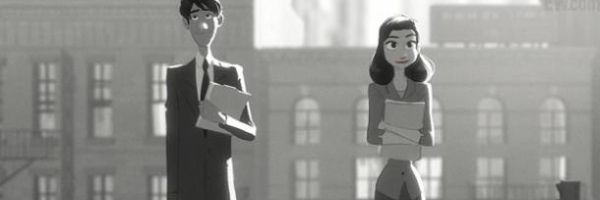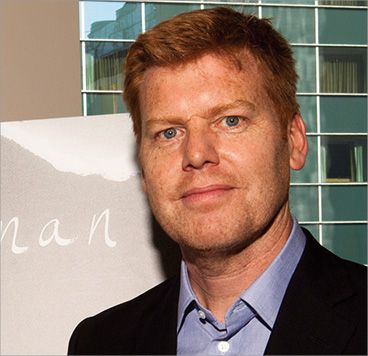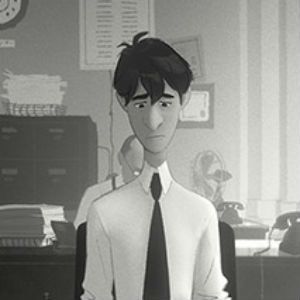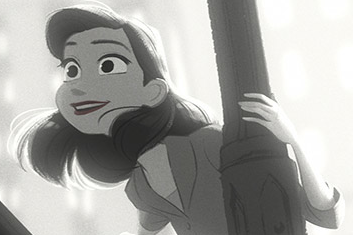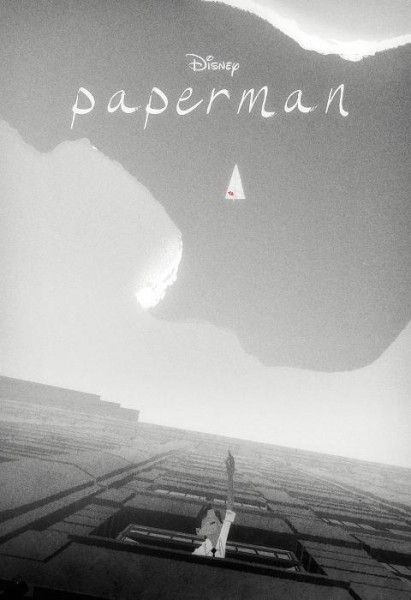The black-and-white short Paperman, running with the new Disney animated feature Wreck-It Ralph, follows the story of a lonely young man in New York City, whose destiny takes an unexpected turn after a chance meeting with a beautiful woman on his morning commute. Convinced the girl of his dreams is gone forever, he gets a second chance when he spots her in a skyscraper window across the avenue from his office, and sets out to get her attention.
At the press day for Wreck-It Ralph, Paperman director John Kahrs (animation supervisor for Tangled, and an animator on Ratatouille, The Incredibles and Monsters Inc.) talked about how the idea for this short came about, why he decided not to include any dialogue, using a blend of 2D and CG to execute his vision, the biggest challenge in doing a short versus a full-length feature, and his favorite short. He also talked about the difference between Disney and Pixar animation, what he’s working on now, and whether or not Disney is looking to animate any Marvel properties. Check out what he had to say after the jump.
Question: How did the idea for this short come about?
JOHN KAHRS: I got to thinking about, “What if two people that were perfect for each other met and then lost each other? How would the fates conspire to bring these two people back together again?” I had pitched it a number of times before, but the stars were not aligned until after Tangled was over. They were looking for things to push technology and fill people’s time in that gap between Tangled and Wreck-It Ralph. It was all edited together already, so they were like, “This one’s all there, so let’s go with this one.” So, it’s a way of pushing things that need to be pushed, to prepare for the upcoming features, and it’s a way of grooming talent, leadership and directors. It’s handy.
What made you decide not to have any dialogue?
KAHRS: I really admire visual storytelling that shows you what’s happening, instead of tells you what’s happening. I think it really forces the filmmaking to be very clear. You have to distill it down to its essence. And I think animation is a really good medium for that. It makes it really easy to carry it around the world and show it to anyone.
Are you this romantic, in real life?
KAHRS: I didn’t meet my wife at first sight, on the street, but I do believe that people can feel that connection. That really comes from my time living in New York and commuting through Grand Central Station. You’d make eye contact with somebody and think, “We could have a life together,” and then that person would drift away or be gone forever, and you wonder about who they were and whether you were perfect for each other or not, and you’ll never know because that person is gone forever. That, coupled with those canyon spaces, and the light and shadow between buildings in New York, is a really cool environment to have a love story take place.
To execute your vision, you used a blend of 2D and CG. How did you arrive at that decision?
KAHRS: Well, I worked very closely with Glen Keane on Tangled, and just being at Disney and being around the drawings so much, I started to think, “Isn’t there a way we can get these drawings to move on top of a base layer of computer generated forms?” I had some very silly ideas about how that would work, technologically, but eventually, these people that were really sharp figured it out and did it in a really cool way that retains that flatness of the drawn line without making it look like it’s painted on. I wanted something that felt like it had that stability and that rich, subtle motion in the dimensionality of CG, but had that flat quality and that expressive line that comes from the 2D animation. And I wanted you to wonder, “I can’t tell if it’s this or that, but I don’t care because I love what I’m seeing.” It was important not to be distracted by it, but to be drawn into the storytelling of it. I hope that we succeeded in that.
Is there a torn sentiment among animators, of loving hand drawn animation, but also having all the things you can do with computers?
KAHRS: Yeah, absolutely! What Ralph looks like is fantastic. I love that kind of stylized photorealism. That’s the prevalent way that CG looks, these days, and we do a phenomenal job of it, but I feel like it can’t be the only way that animation can look. So, this is an attempt to bring that drawn line back into it. You just can’t make 2D the same old, same old, either. It’s good to invigorate it with new technology. Walt Disney was always doing that. Throughout the first 34 years, there are so many different things that he brought to it, technologically. It kept getting more and more mature. It’s definitely a 21st century thing now. Even if you look at The Princess and the Frog, which has a very traditional look, it’s totally infused with digital technology. It’s assembled and managed completely on computers. So, we’re already in that hybrid era, it’s just a matter of how much we can see that line work again and what you do with that line work and how you tell stories with it.
Having worked on feature films, what was the biggest challenge, in doing a short?
KAHRS: When I was at Pixar, I was in my hole. I was an animator, I had my shots and I was like, “Yeah, I’ve gotta make this perfect!” It’s a very selfish thing. But, as a supervisor on Tangled, I had to learn that I couldn’t go in my hole anymore. I had to be there for people. And as a director, whether it’s shorts or features, you just have to be out there and available for everybody. You have to give all of yourself away, every day, all the time. You always have to be available for people, and you have to be clearly stating what you want to see, in so many disciplines, all at the same time. The shorts program at Disney is a really good way of having people that aren’t directors shift their mind-set to understand what it’s like to be in that role. With a short, everything is in miniature. You have all the same departments and the same kind of roles, and the stakes are still there. I think the short, in particular, forces you to distill your ideas down to the bare minimum that you can handle. You don’t want it to drag. You don’t want the short to be longer than it should be. Pixar has always pushed for the shorts to be five minutes or less. If you can do it in six minutes, you can probably do it in five minutes. It forces you to get rid of the dead weight and take out ideas that don’t really matter.
Do you have any favorite shorts?
KAHRS: One of my favorite Disney things ever is The Sorcerer’s Apprentice from Fantasia. You feel the DNA of that in the short, when the magic kicks in. What I love and admire in film goes all over. I’m a big David Lean and [Stanley] Kubrick fan. I like Frank Capra, a lot. But, there’s a lot to be learned from the Disney shorts, all through the era. I have my favorites, of course. In the Bag, with the bears picking up trash, and they sing a little song about it, and there’s a little park ranger that makes them clean it up, is so hilarious. I think that’s my all-time favorite Disney short. But, Paperman has to exist in its own universe. I had to make decisions that made it feel right for itself.
Having worked at both Pixar and Disney, is there an essential difference in their ethos?
KAHRS: Oh, yeah! Each is their own little universe. Pixar makes movies that make sense for Pixar, and Disney makes movies that make sense for Disney, and they’ve each emerged in their own unique way. I think Glen Keane said it best when he said, “Pixar starts their movies with the question, ‘Wouldn’t it be cool if . . .,’ and Disney starts its movies with, ‘Once upon a time . . .’” And I think that speaks a lot about the legacy of Disney and the tradition of bringing fairy tales to life with animation. There’s still a bit of a traditionalist thing going on with Disney that I think is nice. It’s fun to take that history and try to direct it into a new place. The studio is really healthy, and I think the next 10 years are going to be really exciting. You’re going to see awesome stuff.
What upcoming projects do you have going on?
KAHRS: Well, I have this test that I’m doing that’s the next generation of the software that we used to make Paperman. It was really John [Lasseter] seeing what we did with Paperman and thinking, “Okay, what about this? Can you do a full color, organic environment with trees and foliage? Do a test that pushes it visually in another direction and let’s see what we can do with this technology.” So, it’s not necessarily saying, “We have a feature in development with this,” it’s more saying, “Let’s take the next step to get towards that.” I think it’s a really watchable technique. It draws me in, as a viewer, and it doesn’t distract me. For John, it’s a big deal that it won’t be a distraction and that it draws you into the storytelling. That’s what I’m working on, right now. It’s a 90-second test that’s an in between project for me. And there are movies in various states, coming through development into production. We’ll see.
Now that Disney owns Marvel, is the animation department looking at any of those properties?
KAHRS: Maybe. You’ll see.
Paperman plays with Wreck-It Ralph.

